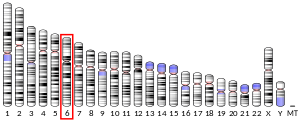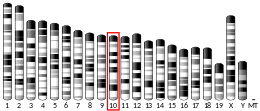Protein-coding gene in the species Homo sapiens
| AKAP12 |
|---|
|
| Identifiers |
|---|
| Aliases | AKAP12, AKAP250, SSeCKS, A-kinase anchoring protein 12 |
|---|
| External IDs | OMIM: 604698; MGI: 1932576; HomoloGene: 3740; GeneCards: AKAP12; OMA:AKAP12 - orthologs |
|---|
| Gene location (Human) |
|---|
 | | Chr. | Chromosome 6 (human)[1] |
|---|
| | Band | 6q25.1 | Start | 151,239,967 bp[1] |
|---|
| End | 151,358,559 bp[1] |
|---|
|
| Gene location (Mouse) |
|---|
 | | Chr. | Chromosome 10 (mouse)[2] |
|---|
| | Band | 10|10 A1 | Start | 4,216,380 bp[2] |
|---|
| End | 4,309,470 bp[2] |
|---|
|
| RNA expression pattern |
|---|
| Bgee | | Human | Mouse (ortholog) |
|---|
| Top expressed in | - pons
- lateral nuclear group of thalamus
- spinal ganglia
- trigeminal ganglion
- vena cava
- Pars compacta
- saphenous vein
- superior vestibular nucleus
- pericardium
- epithelium of colon
|
| | Top expressed in | - efferent ductule
- seminiferous tubule
- vas deferens
- stroma of bone marrow
- external carotid artery
- left lung lobe
- spermatid
- superior cervical ganglion
- endothelial cell of lymphatic vessel
- dermis
|
| | More reference expression data |
|
|---|
| BioGPS |  | | More reference expression data |
|
|---|
|
| Gene ontology |
|---|
| Molecular function | - protein kinase A binding
- protein binding
- adenylate cyclase binding
| | Cellular component | - plasma membrane
- cell cortex
- cytoskeleton
- membrane
- focal adhesion
- cytoplasm
- cytosol
- Schaffer collateral - CA1 synapse
- neuronal cell body
| | Biological process | - protein targeting
- G protein-coupled receptor signaling pathway
- regulation of protein kinase C signaling
- signal transduction
- positive regulation of protein kinase A signaling
- adenylate cyclase-inhibiting G protein-coupled receptor signaling pathway
- regulation of protein kinase A signaling
- modulation of chemical synaptic transmission
- response to lipopolysaccharide
- hepatic stellate cell activation
- negative regulation of vascular permeability
- response to electrical stimulus
- positive regulation of nitric-oxide synthase biosynthetic process
- positive regulation of hepatic stellate cell migration
- positive regulation of ERK1 and ERK2 cascade
- cellular response to interleukin-1
- cellular response to tumor necrosis factor
- positive regulation of oligodendrocyte apoptotic process
| | Sources:Amigo / QuickGO |
|
| Orthologs |
|---|
| Species | Human | Mouse |
|---|
| Entrez | | |
|---|
| Ensembl | | |
|---|
| UniProt | | |
|---|
| RefSeq (mRNA) | |
|---|
NM_005100
NM_144497
NM_001370346 |
| |
|---|
| RefSeq (protein) | |
|---|
NP_005091
NP_653080
NP_001357275 |
| |
|---|
| Location (UCSC) | Chr 6: 151.24 – 151.36 Mb | Chr 10: 4.22 – 4.31 Mb |
|---|
| PubMed search | [3] | [4] |
|---|
|
| Wikidata |
| View/Edit Human | View/Edit Mouse |
|
A-kinase anchor protein 12, aka AKAP250, is an enzyme that in humans is encoded by the AKAP12 gene.[5][6]
Function
The A-kinase anchor proteins (AKAPs) are a group of structurally diverse proteins, which have the common function of binding to the regulatory subunit of protein kinase A (PKA) and confining the holoenzyme to discrete locations within the cell. This gene encodes a member of the AKAP family. The encoded protein is expressed in endothelial cells, cultured fibroblasts, and osteosarcoma cells. It associates with protein kinase A and C and phosphatase, and serves as a scaffold protein in signal transduction. This protein and RII PKA colocalize at the cell periphery. This protein is a cell growth-related protein. Antibodies to this protein can be produced by patients with myasthenia gravis. Alternative splicing of this gene results in two transcript variants encoding different isoforms.[6]
Interactions
AKAP12 has been shown to interact with Beta-2 adrenergic receptor.[7][8]
References
- ^ a b c GRCh38: Ensembl release 89: ENSG00000131016 – Ensembl, May 2017
- ^ a b c GRCm38: Ensembl release 89: ENSMUSG00000038587 – Ensembl, May 2017
- ^ "Human PubMed Reference:". National Center for Biotechnology Information, U.S. National Library of Medicine.
- ^ "Mouse PubMed Reference:". National Center for Biotechnology Information, U.S. National Library of Medicine.
- ^ Nauert JB, Klauck TM, Langeberg LK, Scott JD (Mar 1997). "Gravin, an autoantigen recognized by serum from myasthenia gravis patients, is a kinase scaffold protein". Curr. Biol. 7 (1): 52–62. Bibcode:1997CBio....7...52N. doi:10.1016/S0960-9822(06)00027-3. PMID 9000000. S2CID 18843778.
- ^ a b "Entrez Gene: AKAP12 A kinase (PRKA) anchor protein (gravin) 12".
- ^ Fan G, Shumay E, Wang H, Malbon CC (Jun 2001). "The scaffold protein gravin (cAMP-dependent protein kinase-anchoring protein 250) binds the beta 2-adrenergic receptor via the receptor cytoplasmic Arg-329 to Leu-413 domain and provides a mobile scaffold during desensitization". J. Biol. Chem. 276 (26): 24005–14. doi:10.1074/jbc.M011199200. PMID 11309381.
- ^ Shih M, Lin F, Scott JD, Wang HY, Malbon CC (Jan 1999). "Dynamic complexes of beta2-adrenergic receptors with protein kinases and phosphatases and the role of gravin". J. Biol. Chem. 274 (3): 1588–95. doi:10.1074/jbc.274.3.1588. PMID 9880537.
External links
Further reading
- Lester LB, Scott JD (1997). "Anchoring and scaffold proteins for kinases and phosphatases". Recent Prog. Horm. Res. 52: 409–29, discussion 429–30. PMID 9238861.
- Michel JJ, Scott JD (2002). "AKAP mediated signal transduction". Annu. Rev. Pharmacol. Toxicol. 42: 235–57. doi:10.1146/annurev.pharmtox.42.083101.135801. PMID 11807172.
- Yildirim M, Paydas S, Tanriverdi K, Seydaoglu G, Disel U, Yavuz S (2007). "Gravin gene expression in acute leukaemias: clinical importance and review of the literature". Leuk. Lymphoma. 48 (6): 1167–72. doi:10.1080/10428190701377055. PMID 17577780. S2CID 35975874.
- Gordon T, Grove B, Loftus JC, O'Toole T, McMillan R, Lindstrom J, Ginsberg MH (1992). "Molecular cloning and preliminary characterization of a novel cytoplasmic antigen recognized by myasthenia gravis sera". J. Clin. Invest. 90 (3): 992–9. doi:10.1172/JCI115976. PMC 329955. PMID 1522245.
- Sato N, Kokame K, Shimokado K, Kato H, Miyata T (1998). "Changes of gene expression by lysophosphatidylcholine in vascular endothelial cells: 12 up-regulated distinct genes including 5 cell growth-related, 3 thrombosis-related, and 4 others". J. Biochem. 123 (6): 1119–26. doi:10.1093/oxfordjournals.jbchem.a022051. PMID 9604001.
- Shih M, Lin F, Scott JD, Wang HY, Malbon CC (1999). "Dynamic complexes of beta2-adrenergic receptors with protein kinases and phosphatases and the role of gravin". J. Biol. Chem. 274 (3): 1588–95. doi:10.1074/jbc.274.3.1588. PMID 9880537.
- Lin F, Wang Hy, Malbon CC (2000). "Gravin-mediated formation of signaling complexes in beta 2-adrenergic receptor desensitization and resensitization". J. Biol. Chem. 275 (25): 19025–34. doi:10.1074/jbc.275.25.19025. PMID 10858453.
- Fan G, Shumay E, Wang H, Malbon CC (2001). "The scaffold protein gravin (cAMP-dependent protein kinase-anchoring protein 250) binds the beta 2-adrenergic receptor via the receptor cytoplasmic Arg-329 to Leu-413 domain and provides a mobile scaffold during desensitization". J. Biol. Chem. 276 (26): 24005–14. doi:10.1074/jbc.M011199200. PMID 11309381.
- Grove BD, Bruchey AK (2001). "Intracellular distribution of gravin, a PKA and PKC binding protein, in vascular endothelial cells". J. Vasc. Res. 38 (2): 163–75. doi:10.1159/000051043. PMID 11316952. S2CID 6002979.
- Sasaki H, Kunimatsu M, Fujii Y, Yamakawa Y, Fukai I, Kiriyama M, Nonaka M, Sasaki M (2001). "Autoantibody to gravin is expressed more strongly in younger and nonthymomatous patients with myasthenia gravis". Surg. Today. 31 (11): 1036–7. doi:10.1007/s005950170020. PMID 11766078. S2CID 22167880.
- Piontek J, Brandt R (2003). "Differential and regulated binding of cAMP-dependent protein kinase and protein kinase C isoenzymes to gravin in human model neurons: Evidence that gravin provides a dynamic platform for the localization for kinases during neuronal development". J. Biol. Chem. 278 (40): 38970–9. doi:10.1074/jbc.M306749200. PMID 12857743.
- Tao J, Wang HY, Malbon CC (2003). "Protein kinase A regulates AKAP250 (gravin) scaffold binding to the beta2-adrenergic receptor". EMBO J. 22 (24): 6419–29. doi:10.1093/emboj/cdg628. PMC 291823. PMID 14657015.
- Choi MC, Jong HS, Kim TY, Song SH, Lee DS, Lee JW, Kim TY, Kim NK, Bang YJ (2004). "AKAP12/Gravin is inactivated by epigenetic mechanism in human gastric carcinoma and shows growth suppressor activity". Oncogene. 23 (42): 7095–103. doi:10.1038/sj.onc.1207932. PMID 15258566.
- Ballif BA, Villén J, Beausoleil SA, Schwartz D, Gygi SP (2004). "Phosphoproteomic analysis of the developing mouse brain". Mol. Cell. Proteomics. 3 (11): 1093–101. doi:10.1074/mcp.M400085-MCP200. PMID 15345747.
- Streb JW, Miano JM (2005). "AKAP12alpha, an atypical serum response factor-dependent target gene". J. Biol. Chem. 280 (6): 4125–34. doi:10.1074/jbc.M412466200. PMID 15590635.
- Streb JW, Miano JM (2005). "Cross-species sequence analysis reveals multiple charged residue-rich domains that regulate nuclear/cytoplasmic partitioning and membrane localization of a kinase anchoring protein 12 (SSeCKS/Gravin)". J. Biol. Chem. 280 (30): 28007–14. doi:10.1074/jbc.M414017200. PMID 15923193.

















